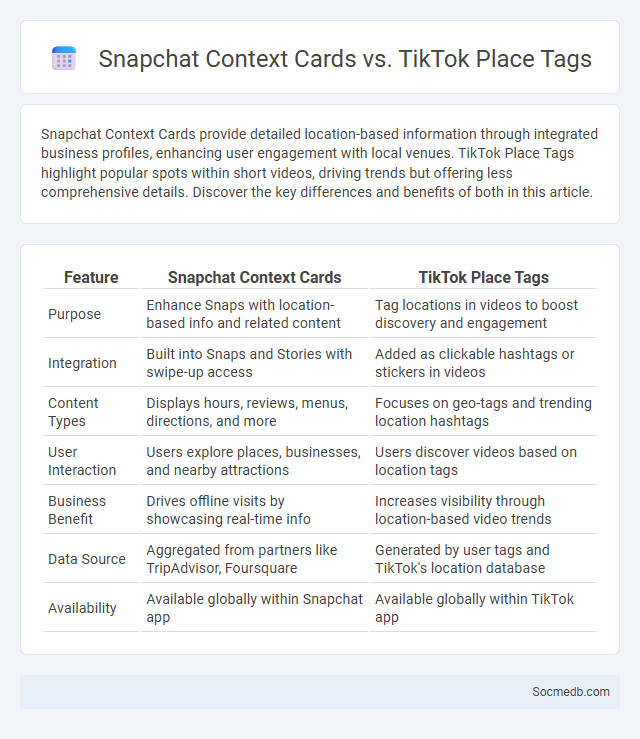
Photo illustration: Snapchat Context Cards vs TikTok Place Tags
Snapchat Context Cards provide detailed location-based information through integrated business profiles, enhancing user engagement with local venues. TikTok Place Tags highlight popular spots within short videos, driving trends but offering less comprehensive details. Discover the key differences and benefits of both in this article.
Table of Comparison
| Feature | Snapchat Context Cards | TikTok Place Tags |
|---|---|---|
| Purpose | Enhance Snaps with location-based info and related content | Tag locations in videos to boost discovery and engagement |
| Integration | Built into Snaps and Stories with swipe-up access | Added as clickable hashtags or stickers in videos |
| Content Types | Displays hours, reviews, menus, directions, and more | Focuses on geo-tags and trending location hashtags |
| User Interaction | Users explore places, businesses, and nearby attractions | Users discover videos based on location tags |
| Business Benefit | Drives offline visits by showcasing real-time info | Increases visibility through location-based video trends |
| Data Source | Aggregated from partners like TripAdvisor, Foursquare | Generated by user tags and TikTok's location database |
| Availability | Available globally within Snapchat app | Available globally within TikTok app |
Snapchat Context Cards: An Overview
Snapchat Context Cards provide users with quick access to detailed information about locations, events, and businesses directly within the app. These cards aggregate reviews, contact details, and navigation options from trusted sources like TripAdvisor, Foursquare, and OpenTable, enhancing user engagement and decision-making. Businesses leveraging Snapchat Context Cards can increase visibility and attract visitors by integrating rich, localized content tailored for real-time social media interactions.
TikTok Place Tags: Key Features
TikTok Place Tags enhance your content's visibility by associating videos with specific locations, boosting local discoverability and engagement. This feature allows creators to tag restaurants, landmarks, or events, making it easier for users to find trending content tied to those places. Leveraging TikTok Place Tags can significantly increase audience reach by tapping into location-based searches and community interests.
What Are Context Cards?
Context Cards provide users with detailed information about a social media account, including its purpose, history, and related content, enhancing transparency and trust. These cards often display verified data, such as the account's location, notable achievements, and links to additional resources, helping Your audience make informed decisions about the credibility of the source. By offering rich contextual information, Context Cards improve user engagement and promote responsible content sharing across platforms.
Comparing User Experience
Social media platforms vary significantly in user experience, with Facebook offering extensive features for community building while Instagram emphasizes visual content and seamless mobile interaction. TikTok provides highly personalized algorithm-driven feeds that keep users engaged through short-form videos, contrasting with Twitter's real-time, text-centric updates ideal for quick news consumption. Understanding these differences helps your social media strategy by aligning platform strengths with your content goals and audience preferences.
Business and Brand Implications
Social media profoundly influences business growth by enhancing brand visibility and fostering direct customer engagement. Leveraging platforms like Instagram, LinkedIn, and Twitter enables businesses to target specific demographics, amplify marketing campaigns, and gather real-time consumer insights. Your brand reputation depends on consistent, authentic interactions that build trust and drive customer loyalty.
Integration with Maps & Locations
Social media platforms increasingly integrate with maps and location services to enhance user experience by providing geo-tagged posts, location-based recommendations, and real-time navigation. This integration allows your content to reach local audiences and enables precise targeting for businesses through location-aware advertising and promotions. Leveraging maps within social media also facilitates event planning, social meetups, and discovery of nearby places, enriching your digital interactions with contextual geographic data.
Data Privacy and User Control
Social media platforms face increasing scrutiny over data privacy practices, emphasizing the need to enhance user control over personal information. Advanced encryption methods and transparent data policies empower users to manage consent and limit data sharing with third parties. Strengthening privacy settings and implementing robust security protocols are critical to protecting user data from unauthorized access and potential breaches.
Engagement Metrics and Effectiveness
Engagement metrics such as likes, comments, shares, and click-through rates provide critical insights into the effectiveness of social media campaigns by measuring audience interaction and content resonance. High engagement rates indicate strong community connection and brand loyalty, driving organic reach and conversions. Analyzing these metrics helps optimize content strategy, improve targeting, and increase overall return on investment (ROI) from social media efforts.
Future Trends in Contextual Content
Future trends in contextual content on social media emphasize hyper-personalization using AI-driven algorithms that analyze user behavior and preferences to deliver highly relevant posts and ads. Augmented reality (AR) and immersive experiences will integrate seamlessly, creating interactive content tailored to your immediate environment and interests. Predictive analytics will enable platforms to anticipate your needs, enhancing engagement through real-time, context-aware storytelling and dynamic content adjustments.
Choosing the Right Tool for Your Strategy
Selecting the appropriate social media platform hinges on understanding your target audience's preferences and behaviors, ensuring alignment with your marketing goals. Platforms like Instagram and TikTok favor visually-driven content and younger demographics, while LinkedIn caters to professional networking and B2B strategies. Utilizing analytics to track engagement and adjusting your tool choice accordingly optimizes reach and conversion rates effectively.
 socmedb.com
socmedb.com